Art & Exhibitions
How 4 National Pavilions at the Venice Biennale Put Innovative Collaboration at the Fore
Collaborative presentations at the 60th Venice Biennale showcased the power of pluralistic authorship.
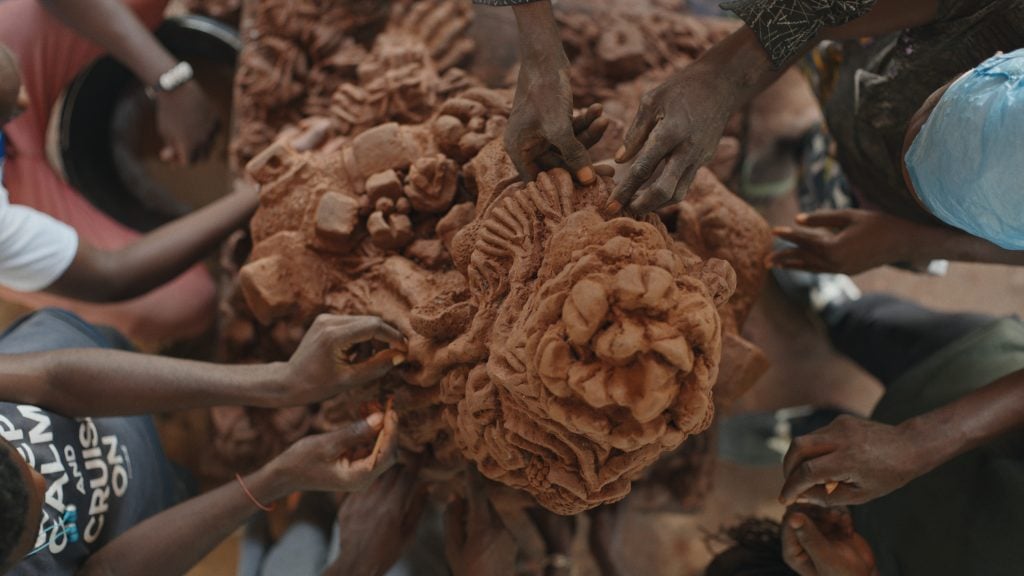
Collaborative presentations at the 60th Venice Biennale showcased the power of pluralistic authorship.

Devorah Lauter

Experiments in pluralistic authorship, including grappling with related practical and conceptual challenges, is one way to advocate for less hierarchical ways of working and displaying art. At the 60th Venice Biennale this year, there were many powerful instances of this kind of collaboration.
Each of the pavilions that undertook blurred authorship or large-scale group shows defined different parameters and unique artistic processes. At their best, they offer a hopeful outlook, rather than striving to smooth out differences and make a single, united oeuvre, they recognize that even jumbled, messy mixtures of opinions and peoples can be powerful forces of creation, and certainly giant steps toward positive directions.
Many of these artists shared a tendency to critique the traditional Western solo exhibition model, with its habit of narrowly recognizing and over-cherishing individual stardom.
The Belgian Pavilion
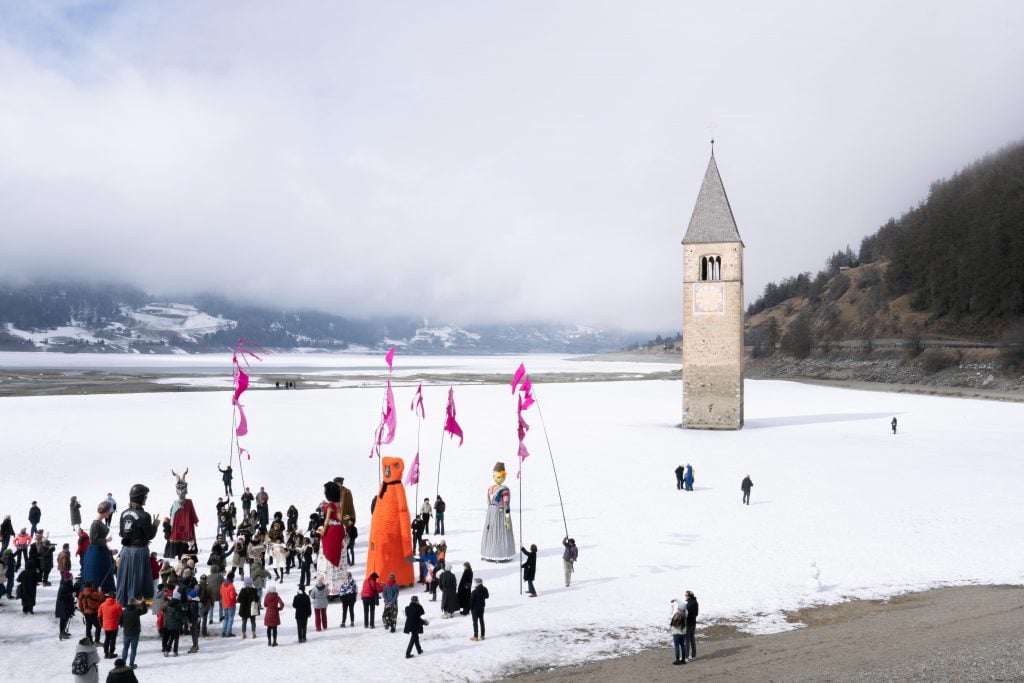
Picnic party at Lago di Resia, Petticoat Government, Belgian Pavilion for La Biennale di Venezia, 9 March 2024. Courtesy Petticoat government (Denicolai & Provoost · Antoinette Jattiot · Nord · Speculoos) Image Lola Pertsowsky.
The Petticoat Government is one of several larger groups or collectives exhibiting at national pavilions in this year’s Venice Biennale. In March, an unlikely picnic gathered atop Italy’s frozen Lake Resia in the Alps. A collective of artists, architects, designers, and a curator, who collectively call themselves the Petticoat Government, were joined by giant, folkloric puppets. The townspeople from around Europe who had made them, along with their friends and families, were also there, standing on the frozen lake which borders Austria and Switzerland—it had been formed by a dam in 1950 to supply electricity to a local power plant, flooding an entire village in the process, and leaving a 14th-century campanile poking out from the water.
Local lore says its bells can sometimes be heard chiming in the wind. The event and art performance, which included drumming and feasting on the ice, was a symbolically charged stop along the Petticoat Government’s journey to Venice, where they are exhibiting the “giants,” as the puppets are called, in the Biennale’s Belgian pavilion before heading elsewhere. Giants are part of a living, Medieval European cultural tradition, designed to celebrate real and legendary figures from local communities who have been making and parading these “soft monuments” through the streets for centuries. Worn and hoisted over the shoulders of individuals who control them from the inside, they are also fragile, made from light wicker and wood. When the giants stepped on the ice, some uncertainty still loomed about how their gaggle would hold up on one of the last days in spring; the melt was faster than usual this year.
“It was moving to see all these people that are politically and ideologically sometimes opposed working towards the same direction to make this improbable event on a frozen lake become a reality,” said artist Ivo Provoost, speaking in an interview. Provoost is also among the seven founders of the Petticoat Government, which is representing Belgium this year at the 60th international biennale (on view until November).
The collective’s project, resonating with this year’s Biennale theme, “Foreigners Everywhere,” addresses the arbitrariness of changing national borders and the poetics of bringing together far-flung individuals to eat and dance, even if on the precarious surface of thinning ice. It is a notion that also illustrates the spirit of the Belgian pavilion’s pluralistic structure, itself “a critique of institutions and relationships to power,” per a statement. The name Petticoat Government refers to alternative, women-led forms of governance, but the group says they are not an actual government and were conceived for the Biennale.
“It was possible to organize all these things that were completely crazy on different levels … because we were working as this team,” said the collective’s Antoinette Jattiot, a curator at the Brussels art center La Loge.
The Dutch Pavilion
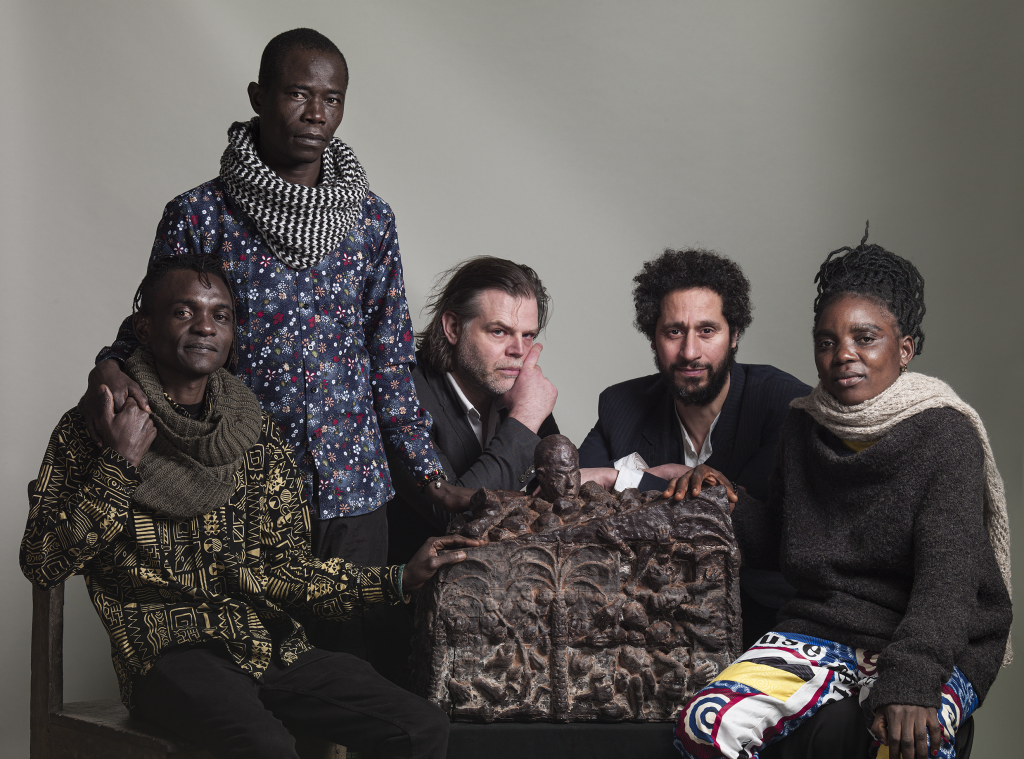
Ced’art Tamasala (CATPC), Matthieu Kasiama (CATPC), Renzo Martens, Hicham Khalidi, Mbuku Kimpala (CATPC). ©Koos_Breukel, 2023
“We don’t have to overcome differences. We can have difference play a part, and we can work across differences,” said curator Hicham Khalidi, selected for the Netherlands pavilion with artist Renzo Martens.
In one of the more radical and complicated examples of multi-person authorship, Martens, in discussion with Khalidi, opted to hand over the Dutch pavilion to a group of 30 to 35 artists from the Congo’s Pende community of plantation workers, who are called Cercle d’Art des Travailleurs de Plantation Congolaise (Congolese Plantation Workers Art League, or CATPC). Martens helped found the CATPC in 2014 and has been working closely with them.
The CATPC, located in Lusanga, DRC, creates clay sculptures from earth in local old-growth forests, which they cast into cacao and palm fat and sell internationally. Examples are currently on view in the Dutch pavilion. With the proceeds, they have bought back 200 hectares of land once belonging to the British-Dutch multinational corporation Unilever and its subsidiaries, and have been cultivating these parcels to regenerate forests that provide food and medicine for locals, in a process they call the “post plantation.”
In the same vein, CATPC has built an “intentionally atemporal, ahistorical modernist” White Cube in Lusanga to exhibit their sculptures, “conceived as a joint initiative with Martens,” designed by Rem Koolhaas’s architecture firm OMA. The White Cube, states the Dutch pavilion’s text, “was intended to ‘repatriate’ some of the social, economic, and cultural capital indebted to the community,” as a form of “reverse gentrification” of the wealth gained via the plantation economy, which has helped finance the white cubes of the art world.
The CATPC’s White Cube juts out of Lusanga’s forested landscape, imposing a harsh, minimalist architecture in angles of warped, cubical perspective. It also holds the second half of the Venice exhibit and hosts a contested ancestral Kwilu Pende wooden sculpture on loan from the Virginia Museum of Fine Arts (VMFA), which is live-streamed into the Dutch pavilion. Known as the “Balot” sculpture, it represents an abusive colonizer who was killed during the Pende Revolt against Belgian colonial rule in 1931.
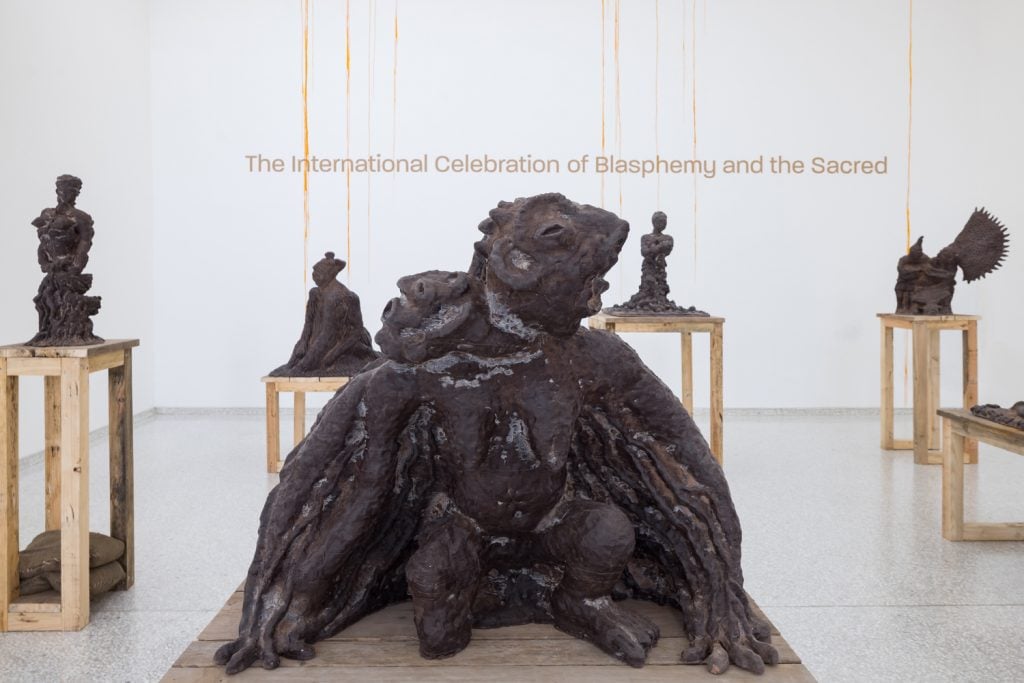
“The International Celebration of Blasphemy and the Sacred,” CATPC, Renzo Martens, Hicham Khalidi, 2024. Photo by Peter Tijhuis.
After inviting the CATPC to exhibit at the Dutch pavilion, Martens formally stepped back from his more prominent role within the group, becoming a CATPC collaborator. “After long deliberation, members of the collective, along with Martens and Khalidi, have decided that CATPC’s project for self-determination cannot be realized without autonomy from Martens’ original vision,” the statement says.
Indeed, Martens’s role as a facilitator, co-founder, and now collaborator of the CATPC is weighted by his being an outsider acting as a self-acknowledged symbol of the white man who has historically exploited the Congo. His project with the CATPC has puzzled, to the point of “intellectual paralysis,” established art-world thinkers, per an essay by Artforum’s Claire Bishop. To further confuse matters, in past presentations of the CATPC’s work, it appeared as though Martens’ driving role was masked, as The New Yorker reported.
Nevertheless, the Dutch pavilion, along with the CATPC, seems to have entered a new phase in its self-identification. Khalidi said all parties have been addressing questions around authorship, for which he also serves as a kind of “mediator.” “Renzo is the stand-in for the West. He’s the white man, who [was] putting himself in the forefront, in order to make this project happen for them, and at the same time, that symbolizes the system of the West that is exploiting the colonial areas,” said Khalidi. “My question to Renzo has always been, ‘who is making the work?’” It became clear that, for the Dutch pavilion, the “responsible” move was “to speak in the words of the collective … to make sure that they are heard.”
And increasingly, they are. “We’ve acquired our autonomy, and we work on it every day,” said the CATPC in an email. “With the revenue from this art that is our ‘gateway’ in the world, we can plant … sacred forests from which our communities can feed … or care for themselves (natural, traditional medicine), all of which is free thanks to the agro-forestry initiative we have initiated, and which we will continue to implant in Lusanga in order to have a real impact on our communities and region.” It must also be mentioned that at the Biennale opening, one member of the CATPC, Blaise Mandefu Ayawo, 55, fell ill and died soon afterward, on April 29.
While the collective said they have now “separated from the former alliance with a few partners, (including Renzo),” the CATPC said they are also open to working with anyone who wishes to collaborate, “without any distinctions.”
This, Khalidi clarifies, does not mean Martens is no longer working with the artists. For one, the CATPC could not show at the Dutch pavilion without him, and they are otherwise connected to the artist via his Institute of Human Activities. Martens, [who was not available for comment] “is part of the project … When you look at the entanglement between the West and the non-West, there’s no way you can disentangle [them],” said Khalidi. They rely on each other. “The West can fend for itself, only because there is a non-West.”
The Hãhãwpuá Pavilion
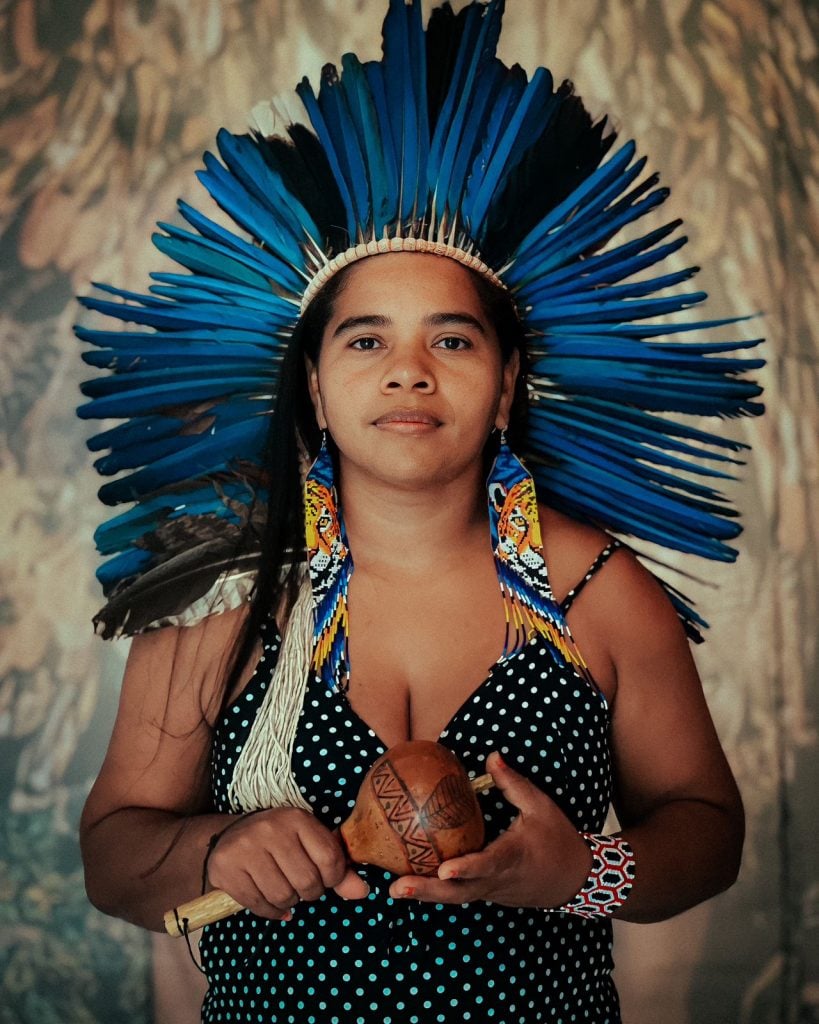
Glicéria Tupinambá. Photo courtesy of the São Paulo Biennial Foundation
Attempting to embrace cultural entanglement forms the running thread through many of the collaborative art projects at the Venice Biennale this year. The Brazilian Pavilion, renamed the Hãhãwpuá Pavilion in reference to the Indigenous Pataxó people’s word for the region, the selected artist and activist Glicéria Tupinambá opted to work in collaboration with the Tupinambá Community, on a series of capes. Meanwhile, artists Olinda Tupinambá and Ziel Karapotó also made contributions.
“My work is inspired by the ones who came before me: my ancestors,” said Glicéria Tupinambá in an e-mail. “My aunts, grandmothers, the elders in my community… My research comes from immersing myself in the references I gather from them, which sometimes are in museums, sometimes are in a knitting point or a knot. I seek out their remnants as they are the foundation upon which I am built.”
About the pavilion’s intuitively collaborative process, its curators Arissan Pataxó, Denilson Baniwa, and Gustavo Caboco Wapichana, said. “For someone of Indigenous origins, the decision to work collectively within the community is so natural that there is no debate about whether it’s the right approach … Each person naturally takes part in what they identify with the most and begins to work so that the final project is accomplished without erasing their identity imprint from the process.”
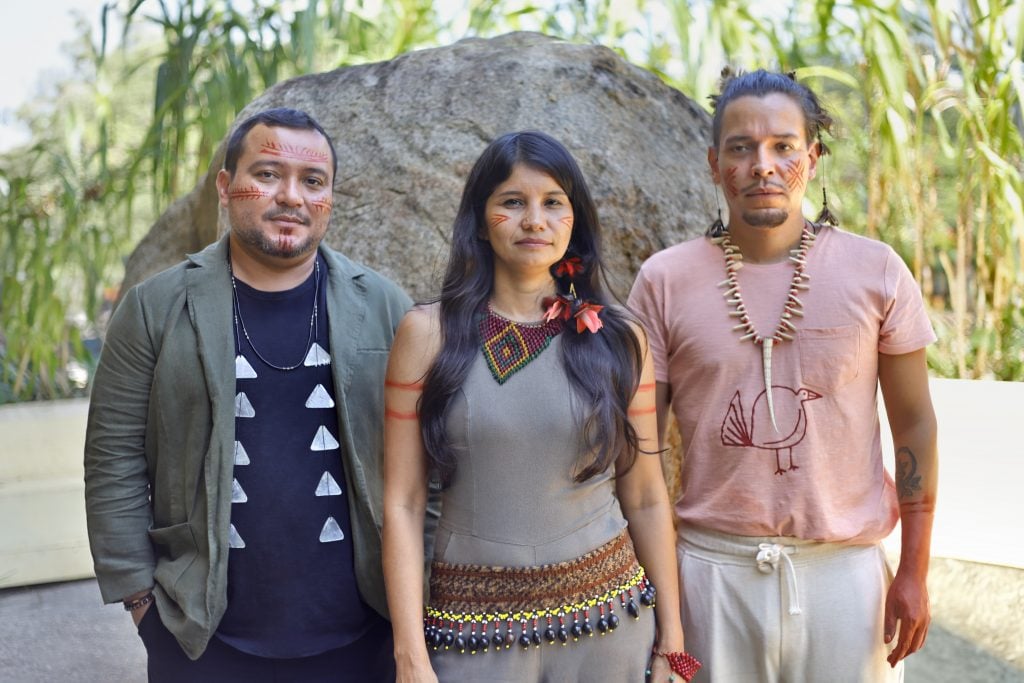
Curators Denilson Baniwa, Arissana Pataxo, and Gustavo Caboco Wapichana. Photo: Cabrel. Courtesy of the São Paulo Biennial Foundation
Indeed, “to do things differently would be strange; to do things individually, in isolation, would mean that we weren’t Indigenous,” they added. “The artists act more as catalysts of action rather than executors; this is a distinctive trait among Indigenous artists in Brazil,” the curators explained. “The artwork functions as a bridge between the community, the artists, and the outside world—not a display piece, but a catalyst for tensions, whether related to territory, repatriation, or historical reparations.”
Asked why a group presentation at Venice was important, they were categorical: “This question shouldn’t even be asked. The community should always come first, without the need to discuss whether or not it should be individual or collective. It should be natural for everyone who occupies any space to bring many more people with them. But then we’d be talking about stripping away the white ego, and unfortunately, the Indigenous peoples haven’t yet managed to teach this to the West.”
The Nigerian Pavilion
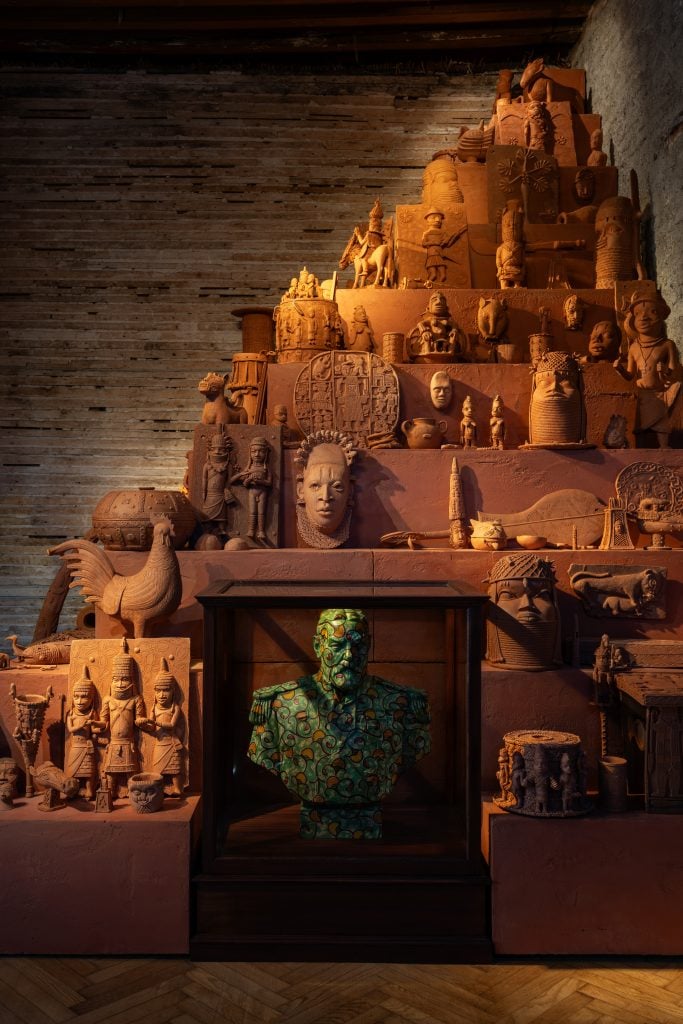
Yinka Shonibare CBE RA, Monument to the Restitution of the Mind and Soul, 2023. Installation view, Nigeria Imaginary at the Nigeria Pavilion at the 60th International Art Exhibition — La Biennale di Venezia. Image: Marco Cappelleti Studio. Courtesy: Museum of West African Art (MOWAA)
Elsewhere, at the Nigerian pavilion, Aindrea Emelife, curator of Modern and Contemporary Art at the Museum of West African Art (MOWAA), selected eight artists to respond to the theme of the “Nigeria Imaginary.” The exhibit title was inspired by the Mbari Club school of thinkers in the early 1960s, when Nigeria became independent, and the group’s explorations into utopian fantasy and colonial experiences. Contemporary artists who made commissioned, site-specific works for the pavilion include Tunji Adeniyi-Jones, Ndidi Dike, Oneyka Igwe, Toyin Ojih Odutola, Abraham Oghobase, Precious Okoyomon, Yinka Shonibare CBE RA, and Fatimah Tuggar. The Nigerian public also contributed via answers to questions such as, “What does Nigeria taste like?” that played on audio.
“I think that no one person, and not even eight artists can represent the collective imaginary of a country. So it was really important to bring community voices into it, and have real-life sitting at the heart of the exhibition,” said Emelife. For its second participation in the Biennale, the curator wanted to “introduce the diversity” of the country. “The richness of the ‘Nigeria Imaginary’ is in these many layers and these many perspectives… Each artist’s work becomes like a point in the manifesto,” she added.
Emelife said she is also responding to misconceptions she hopes to dispel about Nigerian art, particularly concerning “innovation” and form. “I tried to make as diverse a list as possible to eschew this stereotype that African art is very much figurative painting, which I think people still assume,” she said, pointing out works in the show that range from installation, film, and painting, among others.
“African art has been quite entangled with the market – as people see it,” she said. “It almost insinuates that innovation hasn’t reached here yet, and that is obviously not true and is a damaging set of ideas.”
“That’s why I’m really excited for people to see what’s in the exhibition.”
The Nigerian pavilion is also a kind of smaller prequel to an inaugural exhibit at the new MOWAA “campus museum” opening in Benin City. The MOWAA too, is designed with a more collective thinking. It is being built as “a series of buildings, as opposed to one single” monument, said its director, Phillip Ilhenacho. The idea is to “make it more welcoming, and more integrated with the community around us,” with garden and event spaces, punctuated by the first, and largest “engine room” of the campus museum, the 4,500-square-meter MOA Institute, opening in November.
“Innovation,” Emelife said, “is happening in Africa.”